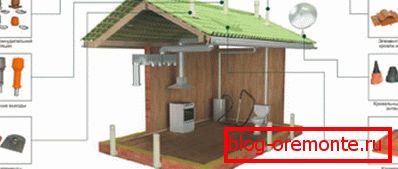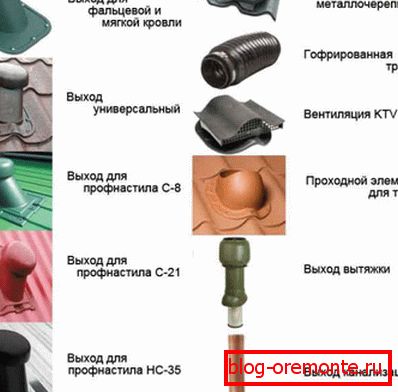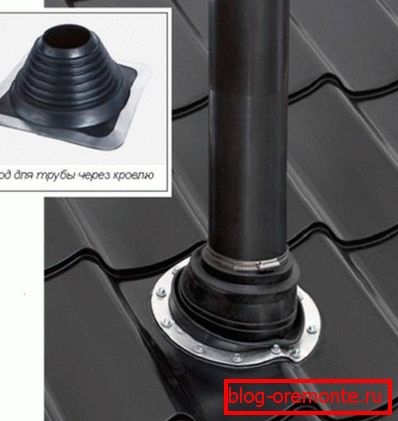Knot passage of ventilation through the roof - photo, video
Ventilation is the most important of the life support systems for structures used as residential, industrial, commercial or administrative. Its task is to remove the exhaust air, saturated with carbon dioxide, polluted or gassed, to the street. To do this, the duct pipe through the ceiling is displayed on the roof of the house. Incorrectly mounted ventilation passage through the roof is often the cause of leaks and problems with the operation of the system. This article will tell how to install roofing penetration to avoid these troubles.
Ventilation system design
A ventilation system is a pipe that provides for the removal of heated air with respiration and vital activity products to the atmosphere. Most private houses are equipped with natural ventilation, the functioning of which is based on the law of convection, the property of heated gases to rise up.
Industrial, administrative and commercial buildings, where there is a large number of people or special equipment works, require enhanced air circulation, which can only be ensured by ventilation, powered by a powerful fan. To determine the type of duct that is suitable for a particular structure, consider the following factors:
- The volume of the room. The larger the area of the house, the more air it contains. This means that more circulation is required to ensure circulation.
- Gas and dust ratio. These indicators are usually calculated for industrial premises, where due to the performance of work or the use of technology, dust and harmful gases appear in the air.
- Humidity and temperature indoors. Ventilation makes the microclimate in the building more suitable for human activity, optimizing humidity and temperature to a comfortable level.
- Number of people. In the process of breathing, people consume oxygen and produce carbon dioxide, so the more people there are in the room, the better the ventilation should work, removing the exhaust air. Therefore, the installation of the duct is made primarily in administrative and commercial buildings.



Note! Another reason to think about the need for ventilation equipment in a private residential building is the presence of heating equipment operating on solid fuel. In the process of burning wood, oxygen is involved, which is why the air in the room “burns out”, it becomes stuffy and difficult to breathe. Therefore, when installing a wood-burning stove or a fireplace, not only they build a chimney, but they also equip the duct passage through the roof.
Types of penetrations
The node passage of the ventilation pipe through the roof - a place on the roof surface, where the duct is carried out on the street. The equipment for the passage of the pipe is considered important and difficult work, since the performance of this task will disrupt the integrity of the truss system and the roof covering. To protect the duct passage through the roof, various penetrations are used to simplify installation. The penetrations used for the vent pipe are of the following types:
- With or without valve. The penetrations for the equipment for the outlet of air pipes are produced with and without a valve. Valve-free models are cheaper, but they are not able to block and regulate the emission of air, they are used in private homes. Valves with a valve have a valve that closes the pipe and stops the movement of air, they are suitable for installing ventilation in production and administrative systems, if they do not work constantly.

- Insulated and non-insulated. Manufacturers produce penetrations equipped with a thermal insulation layer of basalt fiber or glass wool. They are used if the ventilation pipe is located far from the ridge and for the most part is on the street. Insulating layer reduces the difference between the temperature inside and outside the room, thereby reducing the formation of condensate. Non-insulated penetrations are used if the pipe is displayed near the ridge and in regions with a mild climate.
- Automatic and mechanical. Roofing penetrations for air ducts come with manual or automatic control. Mechanical models are equipped with a cable, with which you can regulate air circulation inside the room. They are installed for ventilation systems that operate continuously, where there is no need to frequently switch off or change modes of operation. Automatic penetrations have a controller that electronically controls the operation of the system.

Important! Often, homeowners do not see the difference or confuse the process of equipping the duct and chimney. The temperature of the gases in the chimney is many times higher than the usual air temperature, in solid fuel stoves it reaches 700-800 degrees, so the pipes heat up. To prevent a fire, the chimney outlet is equipped with a fire-resistant box. The passage node through the roof of ventilation does not need fire protection, since the temperature in it is only 0.5-1 degrees higher than room temperature.
Mounting of piles
In modern private houses equipped with gas or wood heating, installation of ventilation is obligatory. During cooking, breathing, washing, drying clothes, as well as performing water procedures, a large amount of water vapor is formed, which must be removed so that the dwelling is not hot, stuffy and humid. The unit of passage through the roof of the ventilation pipe is equipped after the completion of the installation work on the assembly of the duct inside the room. This will require a rubber or silicone sealant (Master Flash), silicone-based sealant, screwdriver, screws, penetration. Installation is as follows:
- The location of the duct is determined. Building codes require vents to be placed in the immediate vicinity of the ridge of the roof so that the hole is located between the rafters.

- Marked place holes. Hole for removal should be 2-3 cm larger than the diameter of the pipe. In order not to be mistaken in size, you can use a marker to draw a pipe on the surface of the roof or to make a pattern out of cardboard.
- The hole is cut. In the designated place of the roof, they make a hole from which it is necessary to remove the insulation, vapor barrier, the remains of the sheathing, as well as waterproofing. To cut a hole in the roof of the metal, you need to drill a few holes on the marked circle with a drill, and then complete the work with a hacksaw or scissors on the metal.
- Roofing is put on the air duct; it should be above the roof surface. Layers of waterproofing and vapor barrier with adhesive tape or sealant are glued to the surface of the pipe. A rubber sealant is put on the penetration, attaching it to the roofing material. If the roof of a metal tile or corrugated board is mounted using self-tapping screws, and if it has a soft coating, the sealant is simply glued with a sealant.

- A protective umbrella is put on the top of the air duct to prevent precipitation, debris or birds from entering the ventilation.
Professional roofers consider that an illiterately equipped knot of passage through the roof of a ventilation pipe causes leakage in 2 cases out of 10. This is often due to the location of the ventilation outlet when a snow pocket does not form around. The snow surrounding the pipe melts over time and penetrates under the roof. Therefore, some masters recommend removing the air duct directly through the ridge. It is worth noting that this method violates the integrity of the truss frame of the roof, therefore, has many opponents.